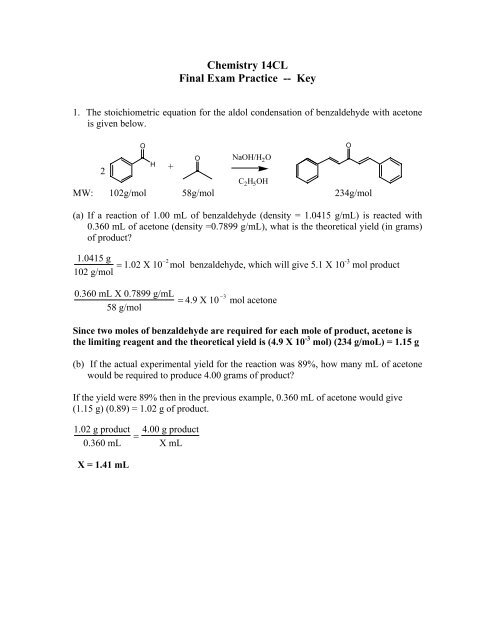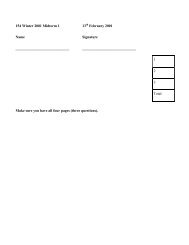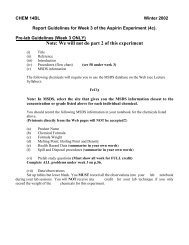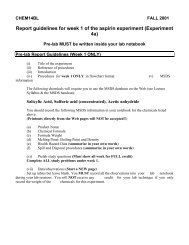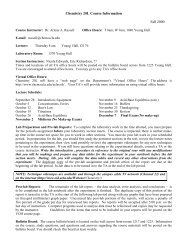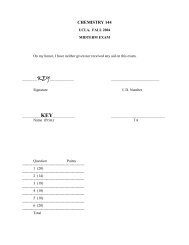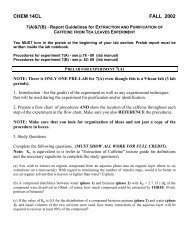14CL Final Practice Key
14CL Final Practice Key
14CL Final Practice Key
You also want an ePaper? Increase the reach of your titles
YUMPU automatically turns print PDFs into web optimized ePapers that Google loves.
Chemistry <strong>14CL</strong><br />
<strong>Final</strong> Exam <strong>Practice</strong> -- <strong>Key</strong><br />
1. The stoichiometric equation for the aldol condensation of benzaldehyde with acetone<br />
is given below.<br />
O<br />
2<br />
H +<br />
O NaOH/H2O C2H5OH MW: 102g/mol 58g/mol 234g/mol<br />
(a) If a reaction of 1.00 mL of benzaldehyde (density = 1.0415 g/mL) is reacted with<br />
0.360 mL of acetone (density =0.7899 g/mL), what is the theoretical yield (in grams)<br />
of product?<br />
1.0415 g<br />
102 g/mol = 1.02 X 10−2 mol benzaldehyde, which will give 5.1 X 10 -3 mol product<br />
0.360 mL X 0.7899 g/mL<br />
58 g/mol<br />
= 4.9 X 10 −3 mol acetone<br />
Since two moles of benzaldehyde are required for each mole of product, acetone is<br />
the limiting reagent and the theoretical yield is (4.9 X 10 -3 mol) (234 g/moL) = 1.15 g<br />
(b) If the actual experimental yield for the reaction was 89%, how many mL of acetone<br />
would be required to produce 4.00 grams of product?<br />
If the yield were 89% then in the previous example, 0.360 mL of acetone would give<br />
(1.15 g) (0.89) = 1.02 g of product.<br />
1.02 g product<br />
0.360 mL<br />
X = 1.41 mL<br />
= 4.00 g product<br />
X mL<br />
O
2. The chromium oxidation of compound I below yields a mixture of products (II – V).<br />
Identify the order of elution that would occur if you used an alumina stationary phase<br />
with diethyl ether to separate the mixture of products (II, III, IV, V) by column<br />
chromatography. (Assume there is no starting material in the products.)<br />
Starting material<br />
Products:<br />
O<br />
C 6H 5-C-C(CH 3) 3<br />
OH<br />
C 6 H 5 -CH-C(CH 3 ) 3<br />
I<br />
CH 3<br />
CH 3-C-OH<br />
CH 3<br />
C 6H 5C<br />
O<br />
H<br />
C 6H 5C<br />
II III IV V<br />
First eluted ______ II _______<br />
Reason: The ketone is the least polar of the oxygen functional groups; in addition<br />
there are two nonpolar hydrocarbon group—an alkyl and an aryl group.<br />
Second eluted ____IV_______<br />
Reason: The aldehyde is slightly more polar than the ketone and this compound<br />
has only one hydrocarbon group—a polarizable aryl group.<br />
Third eluted _____III________<br />
Reason: The alcohol is more polar than the aldehyde or ketone; there is only one<br />
alkyl group.<br />
Fourth eluted ________V___________<br />
Reason: The two oxygens of the acid group make this the most polar compound<br />
of the set. In addition the one hydrocarbon group is a polarizable aryl group.<br />
O<br />
OH<br />
2
3. The molecular structure and the UV spectrum of caffeine are given below.<br />
(a) If the solution used for the spectrum had a concentration of 1mg/40mL of water, what<br />
is the molar extinction coefficient of caffeine at 275nm? (Assume a 1cm diameter<br />
UV cell).<br />
H3C N<br />
C<br />
O<br />
O<br />
C<br />
N<br />
CH3 Molecular formula: C8H10N4O2 (determined from the structure)<br />
Molecular weight = 194 g/mol<br />
Concentration of solution =<br />
A = εbc<br />
C<br />
C<br />
1 mg<br />
40 mL •<br />
CH3 N<br />
N<br />
1mol<br />
CH<br />
194 g/mol = 1.29 X 10−4 M<br />
0.84 = ε(1 cm)(1.29 X 10 -4 M)<br />
ε = 6512 M -1 cm -1<br />
(b) Briefly indicate what feature(s) of caffeine give(s) rise to the UV spectrum.<br />
This absorption is due to a π – π* transition of the chromophore of the<br />
conjugated diene and ketone with auxochromes in the adjacent nitrogen atoms.<br />
3
100<br />
50<br />
120<br />
110<br />
100<br />
0<br />
120<br />
110<br />
100<br />
90<br />
80<br />
70<br />
60<br />
50<br />
40<br />
30<br />
20<br />
10<br />
0<br />
90<br />
80<br />
70<br />
60<br />
50<br />
40<br />
30<br />
20<br />
10<br />
0<br />
4. The 13 C spectrum of caffeine is given below. The signals for each carbon have been<br />
identified and numbered. Draw the DEPT 90 and DEPT 135 caffeine spectra on the<br />
charts below the 13 C spectrum.<br />
156.31(3)<br />
159.24(2)<br />
155.86(4)<br />
142.33(5)<br />
104.08(1)<br />
29.45(8)<br />
32.84(6)<br />
27.90(7)<br />
170 160 150 140 130 120 110 100 90 80 70 60 50 40 30 20<br />
Only<br />
one CH<br />
H3C 7<br />
DEPT 90<br />
170 160 150 140 130 120 110 100 90 80 70 60 50 40 30 20<br />
DEPT 135<br />
170 160 150 140 130 120 110 100 90 80 70 60 50 40 30 20<br />
O<br />
One CH and<br />
3 CH3’s<br />
N<br />
3<br />
O<br />
4<br />
N<br />
CH 3<br />
8<br />
1<br />
2<br />
CH3 6<br />
N<br />
N<br />
5<br />
4
5. (a) The infra red spectrum of caffeine is given below. Identify the functional group or<br />
groups that give rise to the absorption(s) at the specified wavelengths and the type of<br />
vibrations involved.<br />
(i) 2960 cm -1 __________C-H stretch________________<br />
(ii) 1740cm -1 or 1692 cm -1 ___________C=O stretch_______________<br />
(iii) 1240 cm -1 ____C-C or C-N stretches_______________<br />
5
5. (b) The mass spectrum of caffeine is given below. Identify the species that give rise to<br />
the m/z signals at<br />
(i) 194 ___________molecular ion___________________<br />
(ii) 109 Fragmentation occurs next to a carbonyl groups. In this case the<br />
compound breaks on either side of the carbonyl carbons leaving the five-membered<br />
ring and one nitrogen with a methyl group (C8 in the NMR problem) attached<br />
(iii) 15 _______________methyl__________________________<br />
6. A buffer solution is 0.100 M in NaOAc and 0.200 M in HOAc. To 1.00L of this<br />
buffer, 25.0 mL of 0.500 M NaOH is added. Calculate the change in pH that occurs.<br />
Ka of acetic acid = 1.8 X 10 -5<br />
Original buffer: 1.8 X 10 −5 = [H+ ](0.1)<br />
(0.2)<br />
[H + ] = 3.6 X 10 -5 pH = 4.44<br />
Moles of base added = (0.500M)(0.025L) = 0.0125 mol<br />
After addition of base:<br />
[H+] [OAc-] [HOAc]<br />
moles x 0.1 + 0.0125 mol 0.200-0.0125 mol<br />
=0.1125 =0.1875<br />
molarities X 0.1125mol/1.025L 0.1875mol/1.025L<br />
[H + ] = (1.8 X 10−5 )(0.1875)<br />
(0.1125)<br />
= 3.0X10 −5<br />
pH = 4.53 pH change = 0.09<br />
6
7. The internal pH of a muscle cell is 6.8. Calculate the [H2PO4 - ]/[HPO4 2- ] ratio in the<br />
cell. The second dissociation constant of phosphoric acid is 6.31 x 10 -8 .<br />
[H2PO4 - ]/[HPO4 2- ] = [H + ]/Ka = 1.58 x 10 -7 /6.31 x 10 -8 = 2.5/1 = 2.5<br />
8. (a) Hexane (bp = 68 o C) and octane (bp = 125 o C ) form an ideal solution. Draw the<br />
liquid-vapor phase diagram for this system. Label the axes and the phases in each area.<br />
Indicate the temperature at which a 60% octane solution will begin to boil. What is the<br />
composition of the vapor in equilibrium with the solution? What is the composition of<br />
the distillate if there are two theoretical plates in the distillation apparatus?<br />
140<br />
T<br />
E<br />
M<br />
P<br />
E 120<br />
R<br />
A<br />
T<br />
U<br />
100<br />
R<br />
E<br />
O C<br />
80<br />
60<br />
solution<br />
0 0.2 0.4 0.6 0.8 1.0<br />
MOLE FRACTION OF HEXANE<br />
vapor<br />
Initial boiling point<br />
Vapor ~65%hexane<br />
Temp ~ 95 o C<br />
Distillate after two<br />
theoretical plates<br />
~79% hexane<br />
7
(b) Sketch the gas chromatograms that would result if the original mixture and the<br />
distillate were separated by gas chromatography on a non polar column.<br />
Areas 40 60<br />
Original mixture<br />
Distillate<br />
Injection time hexane octane time<br />
Areas 79 21<br />
Injection time hexane octane time<br />
9. The pKa’s for valine are 2.3 and 9.6.<br />
(a) What is the pI (the isoelectronic point pH) for valine?<br />
The isoelectronic point for this amino acid is the average of the pK’s that is, 5.95 ~6<br />
(b) What species are present at pH 7 and in what proportion?<br />
A pH of 7 is sufficiently higher than the isolectronic point that the only two species<br />
present are the zwitterion (major component) and the anion (minor component).<br />
The ratio is 400/1<br />
10. Based on their molecular structures, explain why vitamin C is water soluble and<br />
vitamin A is lipid soluble.<br />
Vitamin C (C5H7O6) has four alcohol groups, and a carbonyl. This many polar<br />
groups with few carbon atoms make the molecule very polar and soluble in water.<br />
Vitamin A (C18H30O)) has only one alcohol group and 18 carbon atoms. The nonpolar<br />
portion of the molecule is too large to be pulled into an aqueous solution by<br />
one OH group.<br />
8


